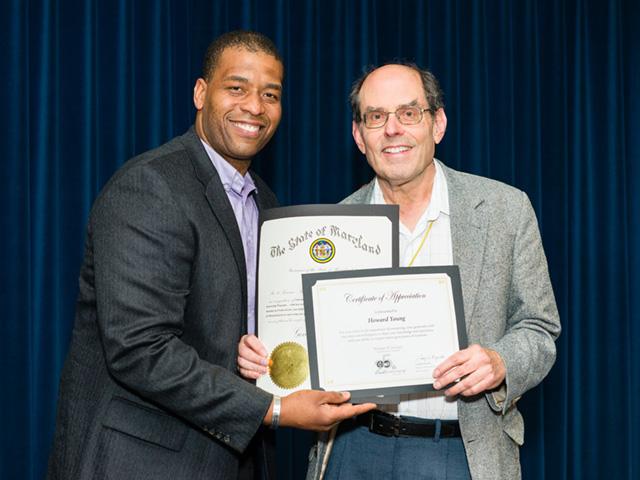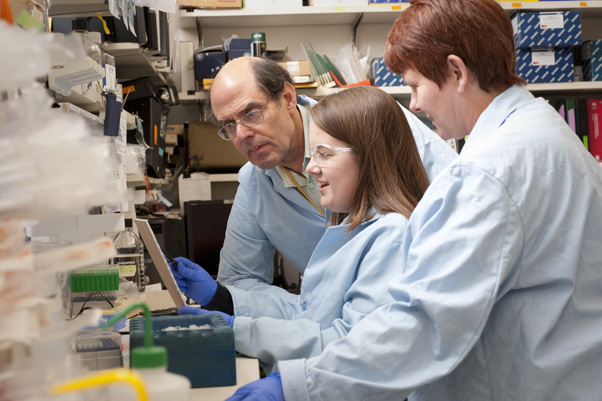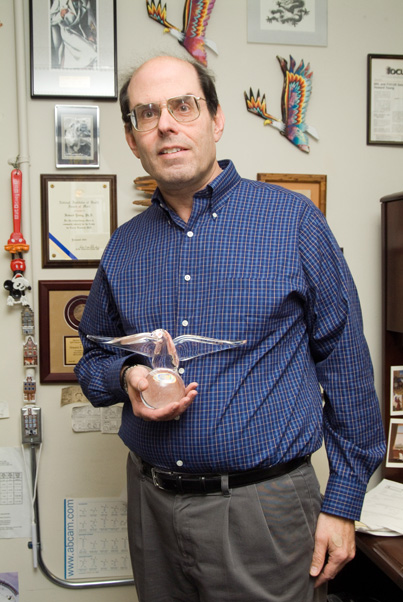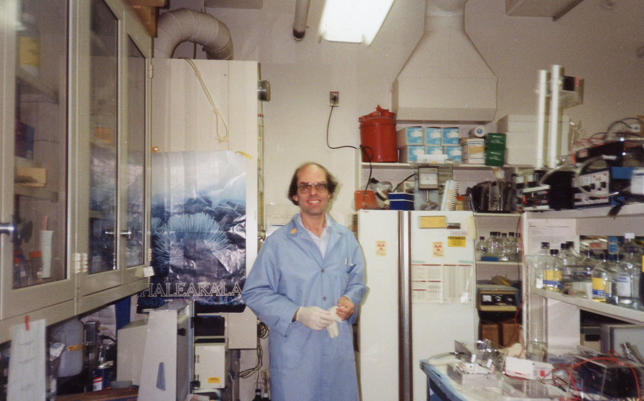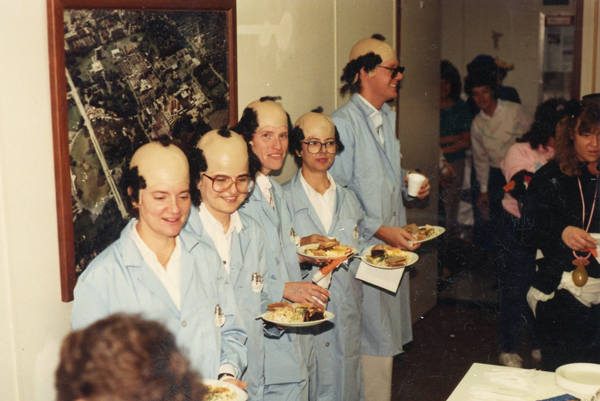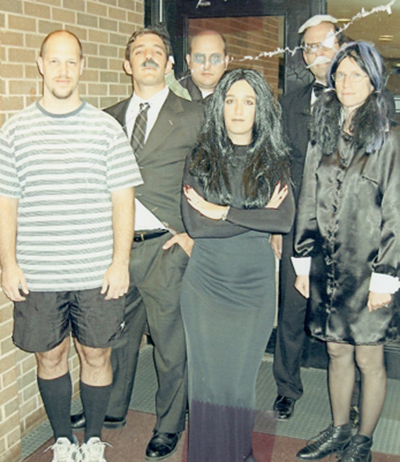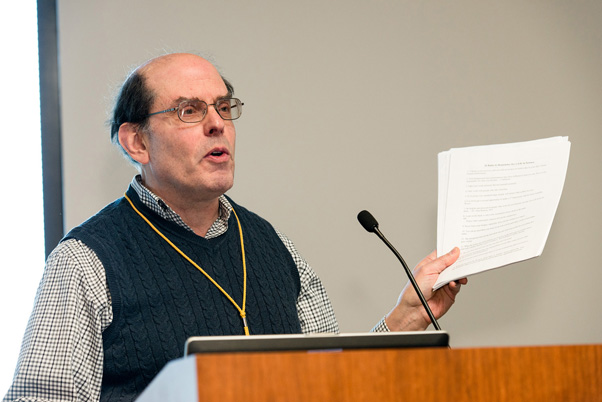You know what they say about all work and no play. And without a doubt, science requires constant hard work. But the NCI at Frederick has an antidote to the serious side of science: Howard Young.
Young, Ph.D., Senior Investigator, Cancer and Inflammation Program, is a serious scientist in his own right. He was part of the team that characterized and cloned the RAS oncogene, he developed a mouse model of lupus, and he was the first to show a clear sex bias, similar to that seen in patients, in what has been called the best mouse model for primary biliary cholangitis.
But Young also works hard to play hard every now and then.
First, there’s Young’s “Food Offense,” a novel disciplinary approach for rehabilitating laboratory minions whose bench-side antics interrupt progress and cause tension in the lab. The famous “Food Offense” was published in the NIH Catalyst and became a standard in other labs. According to the “Food Offense,” if someone does something to interrupt or inconvenience another in the lab, the offending party is required to bring in food—preferably containing chocolate, a request aimed to satisfy Young’s insistent sweet tooth—or, alternately, to get another job.
A sign above Young’s door reads: “A balanced diet is having chocolate in each hand.” And Young isn’t kidding when it comes to his cocoa, even asking those who accidently call his phone to send him the sweet treat. Ram Savan, Ph.D., assistant professor, Department of Immunology, University of Washington, recalled Howard “propos[ing] experiments to study the medicinal properties of chocolate.”
But chocolate isn’t Young’s only love.
When Young was in sixth grade, he visited the Museum of Natural History in New York City and bought a hippo souvenir at the gift shop, kick-starting his collection of more than 200 figurines of the most dangerous animal in Africa. Many of the hippos in his office were gifts, including one that traveled all the way from Uganda, courtesy of an intern who had a hippo hand-carved during her trip back home. Another postdoc went to India and brought Young back a gift—but to his surprise, it was a rhino that the postdoc had mistaken for a hippo. Also adorning Young’s office are faces carved into wood, Japanese fish prints, and other knickknacks from around the world. Out of all the places he has visited for meetings—Great Britain, France, Italy, Portugal, Germany, and Australia, just to name a few—Young’s favorite destination was Shanghai.
Displayed alongside his collectibles are Young’s many distinguished awards, including the Honorary Lifetime Membership Award for the International Cytokine and Interferon Society and the Distinguished Service Award. Young was also nominated for the National Public Service Award for his involvement in student programs and was elected president of the International Society for Interferon and Cytokine Research.
Young became involved in science after being encouraged by his science teachers and realizing that “science was something I could do, so I better stick with it.” After majoring in microbiology, he was encouraged to come to the NIH by a former grad student with whom he had worked at UMass. Throughout his career, he has worked in the Chairman of the Microbiology Department's lab at the University of Massachusetts, then in graduate school at the University of Washington, followed by stints in NCI Bethesda and Frederick research labs. His current work focuses on cellular immunology with a special emphasis on the biology of interferon-gamma. But Young confessed that his heart truly lies with NCI at Frederick, because at Frederick, “science is not a job, as you are part of a community that works together.”
It’s not surprising that a sense of community can be felt in Young’s lab. Della Reynolds, who worked with Young for 28 years, recalled how Young was always part of the “party lab” and was “a great organizer.” Reynolds told stories of Halloween competitions with Young dressed up as Lurch from The Addams Family or a pumpkin from Snoopy. One year, when Young was away for Halloween, the whole lab dressed up as him. Young also emcees the office holiday party luncheon. Daniel McVicar, Ph.D., deputy director for basic science in the Cancer and Inflammation Program, said, “[Young] is fantastic and really is responsible for it being a fun outing.”
Reynolds also credits Young for “always [being] supportive of trying to get people into science.” Jay Bream, Ph.D., associate professor, Department of Molecular Microbiology and Immunology, Johns Hopkins School of Public Health, agreed, saying Young “took it upon himself to do something about it despite the considerable costs in time and effort, [and] marched to the beat of his own drum, giving people a kind of supportive freedom to explore new ideas.”
Young believes that freedom increases morale and allows everyone to help one another succeed. It has also paved the way for many of his contributions to NCI at Frederick, including the WHK Student Intern Program, the Summer Student Seminar Series, the Spring Research Festival, the Take a Hike event, the summer Student Poster Day, the Green Team Plant Exchange, the Frederick Faculty Seminar Series, and the summer Student Jeopardy Tournament. Furthermore, he raised $50,000 in just 30 minutes by asking three NIH Scientific Directors and the NIH Office of Women’s Health to contribute to a meeting on mouse models of lupus. The cost proved to be less than $50,000, and the leftover money was used to organize four additional meetings focused on women’s health issues.
“You have to give back to the community,” Young said. “I think seeing the interns in the WHK program succeed, whether establishing their own research labs or becoming practicing physicians, has shown me that the program is accomplishing what it initially hoped to do and is one that the entire Frederick community can be proud of.”
Young’s influence was perhaps best summarized by Savan, who said, “I want my lab to be a place where people can share their lives together, and [my colleagues] view me with the same respect that I view Howard.”


